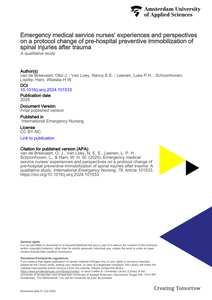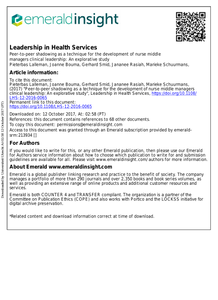ObjectiveIn 2016, a selective preventive spinal immobilization protocol for emergency medical service (EMS) nurses was introduced in the Netherlands. This protocol leaves more room for autonomous decision-making in the pre-hospital phase regarding preventive spinal immobilization (PSI), compared to the previous strict protocol. In this study, we explored the experiences and perspectives of EMS nurses on decisionmaking about PSI after the change from a strict to a selective PSI protocol. Methods: We used a qualitative design with semi-structured face-to-face interviews. Thematic analysis was applied. The capability-opportunity-motivation-behavior-model was used to interpret the experiences and perspectives. Results: Thirteen EMS nurses from three emergency medical services were interviewed. Respondents appreciated autonomous decision-making as there was more room for patient-centered informed decision-making. However, autonomous decision-making required optimized knowledge and skills and elicited the need to receive feedback on their decision not to apply PSI. When nurses anticipated resistance to selective PSI from receiving hospitals, they were doubtful to apply it. Conclusion: Nurses appreciate the increased autonomy in decision-making, encouraging them to focus on patient-centered care. Increased autonomy also places higher demands on knowledge and skills, calling for training and feedback. Anticipated resistance to receiving hospitals based on mutual protocol discrepancies could lead to PSI application by EMS nurses while not deemed necessary. Recommendations: To enhance PSI procedures, optimizing the knowledge and skills of EMS nurses that facilitate on-scene decision-making may be indicated. A learning loop for feedback between the EMS nurses and the involved hospitals may add to their professional performance. More efforts are needed to create support for the changed Emergency Medical Services strategy in PSI to prevent unnecessary PSI and practice variation.
DOCUMENT

Background: Nurse-sensitive indicators and nurses’ satisfaction with the quality of care are two commonly used ways to measure quality of nursing care. However, little is known about the relationship between these kinds of measures. This study aimed to examine concordance between nurse-sensitive screening indicators and nurse-perceived quality of care. Methods: To calculate a composite performance score for each of six Dutch non-university teaching hospitals, the percentage scores of the publicly reported nurse-sensitive indicators: screening of delirium, screening of malnutrition, and pain assessments, were averaged (2011). Nurse-perceived quality ratings were obtained from staff nurses working in the same hospitals by the Dutch Essentials of Magnetism II survey (2010). Concordance between the quality measures was analyzed using Spearman’s rank correlation. Results: The mean screening performances ranged from 63 % to 93 % across the six hospitals. Nurse-perceived quality of care differed significantly between the hospitals, also after adjusting for nursing experience, educational level, and regularity of shifts. The hospitals with high-levels of nurse-perceived quality were also high-performing hospitals according to nurse-sensitive indicators. The relationship was true for high-performing as well as lower-performing hospitals, with strong correlations between the two quality measures (r S = 0.943, p = 0.005). Conclusions: Our findings showed that there is a significant positive association between objectively measured nurse sensitive screening indicators and subjectively measured perception of quality. Moreover, the two indicators of quality of nursing care provide corresponding quality rankings. This implies that improving factors that are associated with nurses’ perception of what they believe to be quality of care may also lead to better screening processes. Although convergent validity seems to be established, we emphasize that different kinds of quality measures could be used to complement each other, because various stakeholders may assign different values to the quality of nursing care.
DOCUMENT

The purpose of this study was to explore the experiences and impact of peer-to-peer shadowing as a technique to develop nurse middle managers’ clinical leadership practices. A qualitative descriptive study was conducted to gain insight into the experiences of nurse middle managers using semi-structured interviews. Data were analysed into codes using constant comparison and similar codes were grouped under sub-themes and then into four broader themes. Peer-to-peer shadowing facilitates collective reflection-in-action and enhances an “investigate stance” while acting. Nurse middle managers begin to curb the caring disposition that unreflectively urges them to act, to answer the call for help in the here and now, focus on ad hoc “doings”, and make quick judgements. Seeing a shadowee act produces, via a process of social comparison, a behavioural repertoire of postponing reactions and refraining from judging. Balancing the act of stepping in and doing something or just observing as well as giving or withholding feedback are important practices that are difficult to develop.
DOCUMENT

Since 2015, the research group Lifelong Learning in Music of Hanze University of Applied Sciences Groningen, together with the University Medical Center Groningen (UMCG), has developed and researched the MiMiC practice for patients and nurses on surgical wards. The musicians make tailor-made music in the patients' rooms in collaboration with patients and nurses. They do this on the basis of verbal and non-verbal contact with patients and nurses. Person-centred music-making turns out to be easy to realise in a medical setting and to be meaningful for all involved. People who have just had surgery experience less pain. Nurses feel more deeply involved with their patients. Musicians show sensitivity for the social context in which they carry out their artistic practice.In this project the research group is developing an innovative artistic practice with a focus on elderly patients. Musicians work with patients and the care staff that are taking care of these patients during their stay in hospital. The research should lead to insights in the effects of this practice and to a new training for master students and professional musicians who want wish to specialise themselves in this field. Pilots on six different wards of the UMCG with professional musicians and master students are part of the research which will last two years in its entirety. The project has been granted funding from the 'Banning de Jong Fonds' of the national 'Prins Bernhard Cultuurfonds' and the 'Fonds Sluyterman van Loo'.
In the Netherlands, 125 people suffer a stroke every day, which annually results in 46.000 new stroke patients Stroke patients are confronted with combinations of physical, psychological and social consequences impacting their long term functioning and quality of live. Fortunately many patients recover to their pre-stroke level of functioning, however, almost half of them never will. Consequently, rehabilitation often means that patients need to adapt to a new reality in their lives, requiring not only physical but also psychosocial adjustments. Nurses play a key role during rehabilitation of stroke patients. However, when confronted with psychosocial problems, they often feel insecure about identifying the specific psycho-social needs of the individual patient and providing adequate care. In our project ‘Early Detection of Post-Stroke Depression’, (SIA RAAK; 2010-12-36P), we developed a toolkit focusing on early identification of depression after stroke continued with interventions nurses can use during hospitalisation. During this project it became clear that evidence regarding possible interventions is scarce and inclusive. Moreover feasibility of interventions is often not confirmed. Our project showed that during the period of hospital admission patients and health care providers strongly focus on surviving the stroke and on the physical rehabilitation. Therefore, we concluded that to make one step beyond we first have to go one step back. To strengthen psychosocial care for patients after stroke we have to add, reconsider and shape knowledge in context of health care practices in a systematic way, resulting in evidence based and practice informed stepping stones. With this project we aim to collect these stepping stones and develop a nursing care programme that improves psychosocial well-being of patients after stroke, is tailored to the particular concerns and needs of patients, and is considered feasible for use in the usual care process of nurses in the stroke rehabilitation pathway.
Polycotton textiles are fabrics made from cotton and polyester. It is used in many textile applications such as sporting cloths, nursery uniforms and bed sheets. As cotton and polyester are quite different in their polymer nature, polycotton textiles are hard to recycle and therefore mostly incinerated. Incineration of discarded polycotton, and substitution by virgin polycotton, create a significant environmental impact. However, textile manufacturers and brand owners will become obliged to apply recycled content in clothing from 2023 onwards. Therefore, the development of more sustainable recycling alternatives for the separation and purification of polycotton into its monomers and cellulose is vital. In a recently approved GoChem project, it has been shown that cotton can be separated from polyester successfully, using a chemical recycling process. The generated solution is a mixture of suspended and partially decolorized cotton (cellulose) and a liquid fraction produced from the depolymerization of the polyester (monomers). A necessary further step of this work is the investigation of possible separation methods to recover the cotton and purify the obtained polyester monomers into polymer-grade pure products suitable for repolymerization. Repolymerize is a new consortium, composed of the first project members, plus a separation and purification process group, to investigate efficient and high yield purification steps to recover these products. The project will focus on possible steps to separate the suspended fraction (cotton) and further recover of high purity ethylene glycol from the rest fraction (polyester depolymerization solution). The main objective is to create essential knowledge so the private partners can evaluate whether such process is technologically and economically feasible.